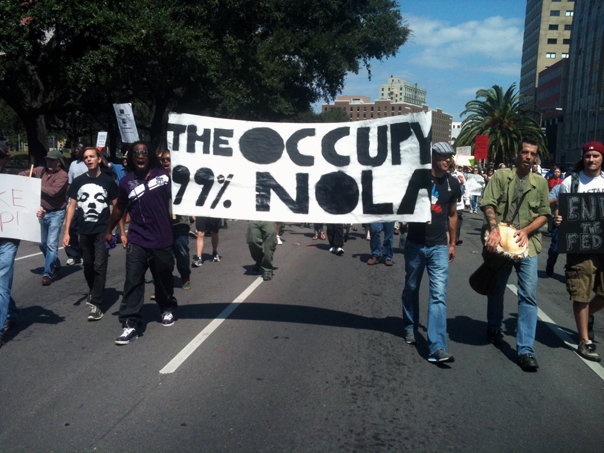By Kira Akerman, The Lens contributing opinion writer |
“The system was never broken it was built this way,” read the hand-painted sign held by a woman in New York City’s Occupy Wall Street protest. The woman was not on Wall Street itself; she was crossing the Brooklyn Bridge in what became one of the largest arrests of nonviolent protesters in United States history. It’s a knotty question— what it means to Occupy Wall Street, when you are nowhere near the street.
Occupy Wall Street is occurring in New Orleans today. As I consider whether to participate, I ask myself: Why does Wall Street matter here? Why are the needles on every compass across the country flickering toward lower Manhattan? I decide to do some research.
Wall Street, I learn, was once an actual wall. It blocked out the indigenous peoples, the Lenape, so that the Dutch could claim the island exclusively for themselves. “But its ‘sale’ was a misunderstanding,” writes Georgetta Stonefish Ryan for the National Museum of the American Indian. Native Americans “did everything by trade, and they did not believe that land could be privately owned, any more than could water, air, or sunlight.” By 1700, the Dutch had secured their settlement. The wall was torn down and became a street.
Any wall — literal or metaphorical — blocks us from seeing, and when we cannot see, we tend toward fear. Manhattan’s steady growth fed on slave labor, and in 1711 Wall Street became the site of New York’s first slave market. Like the one in New Orleans, it was more of a prison than a market. Confining blacks to a specific area allayed colonists’ fear of an uprising.
Slave markets are not the only tradition New Orleans shares with New York. New Orleans also had its wall against a native population, Rampart Street, on the northern edge of the original colony, today’s French Quarter.
Leap to the present and the impulse to create defensive walls persists: the United State-Mexico border fence is one manifestation, Israel’s West Bank Barrier another. In an age of terror, we have become conditioned by color-coded alerts — orange, yellow, red and blue— the color of flames. Firewalls can backfire; fear flames fear.
“Where is the civilization and where, indeed, is the morality which can afford to destroy so many?” asked James Baldwin in an article titled “A Report from Occupied Territory” featured inThe Nation in 1966. Where is the civilization and where is the morality that continues to destroy so many? It seems our morality is sheathed. Walls must be broken if we are to cease deceiving ourselves. Any real change, a revolution, implies a breakthrough, a stripping of safety.
A wall is a wall is a wall. What, I then wonder, is a street? Where a wall separates people and enables one group to exploit or oppress another, a street is an open space, a place to move about. Occupy Wall Street began on a street rife with contradictions. Foremost, the contradiction this country was founded on: freemen and slaves. Our freedom was originally dependent on human capital. Occupy Wall Street addresses this paradox. An official statement reads: “…all people who feel wronged by the corporate forces of the world can know that we are your allies.”
Lastly, I consider the word “occupy.” Writers of various online blogs (Racialicious, Tequilia Sovereign) have pointed out that Wall Street is already an occupied territory; the United States was built on imperial-colonial relations with native peoples, and that they wish to see Occupy Wall Street re-named “Decolonize Wall Street.” But as there is meaning in the words “wall” and “street,” there is meaning in “occupation.” It is appropriate, I think, to use the diction of an empire — “occupation”— and to aspire to reverse its underlying power dynamic.
Thanks to Katrina recovery spending, New Orleans has been relatively isolated from the impact of the ongoing recession. But it would be foolhardy to imagine that the city is immune to Occupy Wall Street’s concerns. More than any American city, New Orleans knows that walls do not weather well. We need only remember the failure of the levees. After some research, some thinking, I decide that Occupy Wall Street is a morally rigorous act that matters here and everywhere. It’s an effort to topple walls so that we may all see each other.
Kira Akerman is an artist and writer who recently moved to New Orleans from New York City.

